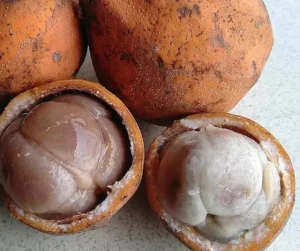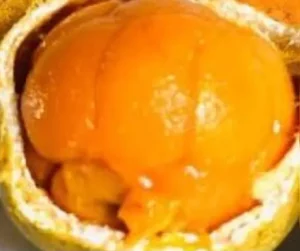Utu Fruit Benefits and Uses
Utu (botanically known as landolphia owariensis and translated as “white rubber vine”) is a seasonal fruit with a sweet or sour taste.
It is commonly marketed in clusters and is high in vitamins A and C. The yellow-orange rind is rough and rounded. It may develop brown speckles as it becomes older.
The color indicates the presence of carotenoid, which gives it its color and benefits the eye and overall vision health.
Phytochemical and Nutritional Profile of Utu
The nutritional and phytochemical composition of Utu (Icacina senegalensis) and sycamore (Ficus sycomorus) were studied using standard analytical techniques. The results revealed that the moisture content of sycamore (9.65 ± 0.10%) is lower than 12.89 ± 0.26% of Utu seeds respectively. therefore, sycamore will have more storage advantage than the Utu seeds. The crude fat value of both seeds are 28.62% and 31.34% for Utu and sycamore respectively. This means that both seeds can serve as an energy supplier in food.
The mineral composition of both seeds were analyzed. The results obtained revealed that copper, sodium and zinc have the least value of minerals in the seeds. Phosphorus, magnesium and calcium content of sycamore seeds are 380.24 ± 0.031, 300.67 ± 0.021, 390.77 ± 0.012mg/100g respectively, they are higher than the results of the utu which are 119.14 ± 0.040, 138.15 ± 0.040, 309.71 ± 0.023% mg/100g.
Phytochemical screening of the two samples shows a small amount of antinutrients like saponin, phytate and flavonoid, etc. The tannin content of Utu is 5.84 ± 0.012% which is higher than 4.03 ± 0.015% of Sycamore. The alkaloid content is higher in sycamore (5.65 ± 0.021%) than that in utu (3.92 ± 0.025%). These values are below the toxic levels, which means that they will not be harmful when consumed.
Utu Fruit
The seeds and pulp form a ball that can be easily separated with your fingers. Unless you come across one with a tart taste, the pulp is luscious and delicious.
After licking the pulp, the seeds/nuts can also be consumed.
Where Can You Find Landolphia Owariensis?
White rubber vine (landolphia owariensis) is a shrubby, vining plant that is commonly seen in the wild.
It is exclusively found in tropical West Africa and is notable for its sticky sap (latex) that seeps out when cut.
In contrast to the white rubber vine, the Landolphia comorensis (mbubgo, bungo, or sapa comorensis), is native to Madagascar and has spread to other tropical areas of Africa, such as West, East, and Central Africa.
Nigeria, Congo, Senegal, Comoros, Tanzania, and Gambia are examples.
In Africa, there are around ten different species of Landolphia. Some of the most common types are:
- Landolphia owariensis (Congo rubber plant/white rubber vine)
- Landolphia heudelotii (Guinea gum vine)
- Landolphia comorensis,
- Landolphia maxima, and so on.
Common names of Landolphia Owariensis
In Igbo, it’s known as Utu, Utu isi enyi, etc. Depending on the dialect, ciwoo, chiwo, or chiyo.

Note: This fruit should not be confused with saba comorensis (the yellow pulp type known as chiyo in Hausa or bungo/mabungo/mavhungo (Rubber Vine)).
Despite being members of the same Apocynaceae family, they exhibit some distinguishing characteristics. Landolphia owariensis has an orange fruit skin and white fruit pulp, whereas Saba comorensis has a yellow fruit peel and fruit pulp.

Also, saba comorensis is bigger than landolphia owariensis.
However, both genera are native to tropical Africa. And fruits from both species may be confusing even when the differences are quite noticeable.
How to use and process Landolphia owariensis (Utu fruit)
1. Ferment the seeds to make wine, beer, tart fruits, and beverages.
2. It enhances the flavor of cereals and other dishes (fish). In some places, utu fruit juice can be substituted with lime juice.
3. The rind is completely covered in latex. As a result, plant latex can be used in the creation of rubber.
4. The twigs form an excellent chewing stick.
5. The stem is sturdy enough to serve as a walking staff.
6. When mixed with the powdered seeds of Strophanthus, the latex is used to capture smaller birds and to prepare an arrowhead poison.
Before now, the tree has been a key source of rubber production in Nigeria and neighboring countries such as Ghana.
Health Benefits of Landolphia Owariensis (Utu) Fruit.
Traditional medicine uses leaves, roots, and stems for antimicrobial, purgative(laxative), and vermifuge(anti-worm action) reasons.
- Drink the aqueous root extract as a laxative.
- Soak the bark in water and drink the resulting solution or extract it as a vermifuge. Latex is taken orally in some parts of Equatorial Guinea for this reason.
- it has analgesic and anti-inflammatory effects. To relieve pain, boiling leaves are placed on the sprain. It can also relieve pain and symptoms of edema and rheumatism by massaging the sap into the affected areas.
- To relieve fever pains, an aqueous extract of the unripe pulp and roots is given via steam bath.
- Drinking the decoction of the leaves may help treat malaria.
- The bark decoction helps in preventing intestinal worms.
- The root extract may be beneficial in the treatment of infections such as gonorrhea. Take the roots orally after soaking them in gins.
- In some regions of Congo, this is used to treat epilepsy and dizziness. For these purposes, the leaf extract is dripped into the eyes and used to wash the face.
- It helps with digestion. To do this, soak them in water and drink the extract for this purpose.
Utu is less perishable than other fruits such as Bush cherry or banana. In terms of exports, it can withstand ocean travel.
It is, however, a seasonal fruit. Yet it isn’t the only issue. The danger is that in a few decades, this fruit and many other species, as well as other seasonal fruits such as bush cherry, icheku, red monkey kola, yellow monkey kola, and so on, may become extinct.

